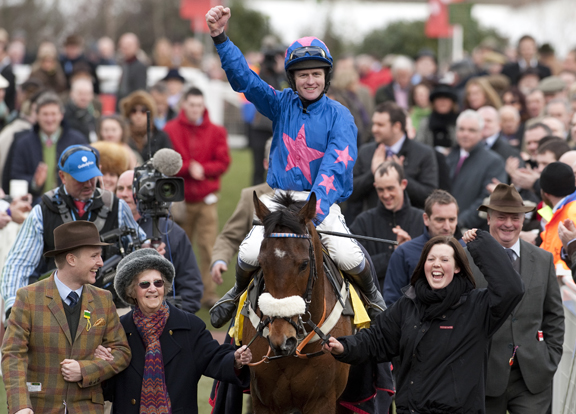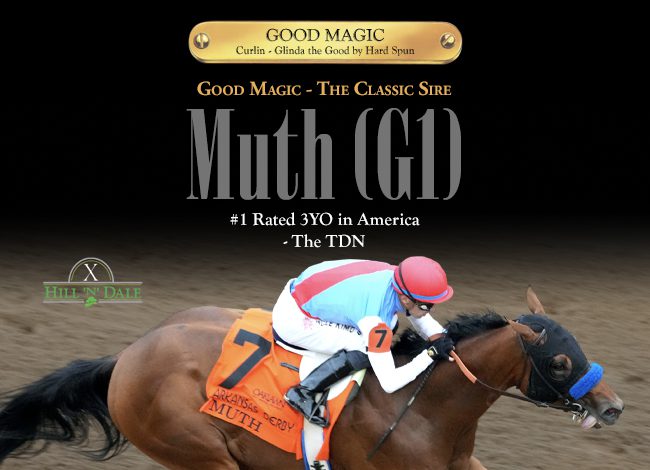By Emma Berry
The TDN's international racing coverage is usually focused strictly on Flat racing, but we'll be making an exception this week to bring you daily round-ups of events from the Cheltenham Festival, colloquially known as National Hunt racing's Olympics.
While jump racing may be very much a second-tier sport in many of the world's racing nations, in Britain, Ireland and France the 'winter game' matters hugely. Its increasing popularity is underscored by the fact that sums of money that wouldn't look out of place at Book 1 of Tattersalls' October Yearling Sale now regularly change hands for potentially top-class jumping prospects. In fact, at last season's Horses-in-Training Sale, the underbidders at 500,000gns on the top lot, Harlem (GB) (Champs Elysees {GB}), were Joe Tizzard and agent Tom Malone. Tizzard's father Colin has been robbed of his Festival star this time around with last year's G1 World Hurdle winner Thistlecrack (GB) (Kayf Tara {GB}) ruled out through injury, but even after that setback the trainer still has two of the top three in the betting, Cue Card (GB) (King's Theatre {Ire}) and Native River (Ire) (Indian River {Fr}), for Friday's showcase, the £575,000 G1 Timico Cheltenham Gold Cup.
Enduring Presence…
When Cue Card steps onto the track on Friday, it will be his fifth appearance at the Festival. The enormously popular chaser burst onto the scene back in 2010 when, as a 4-year-old, he sprinted clear up the Cheltenham hill to win the G1 Weatherbys Champion Bumper by eight lengths on only his second racecourse start. Fourth in the following year's G1 Stan James Supreme Novices' Hurdle and then beaten only by the outstanding Sprinter Sacre (Fr) (Network {Ger}) in the G1 Racing Post Arkle Trophy a year later, he was back in the top spot in 2013 when winning the G1 Ryanair Chase. Cue Card missed out on two subsequent Festivals and fell when in contention for last year's Gold Cup. The people's favourite, now 11 and owned by octogenarian Jean Bishop, is right back at the top of his game this year and would reduce grown men to tears should he prevail in the week's most prestigious contest.
Jumpers are every bit as fragile as Flat horses, and there's been a rash of disappointing Festival scratchings through injury in the last few weeks, but the longevity of some of the big names goes a long way to ensuring that National Hunt racing has an ever-increasing legion of fans who support particular horses in the way they would football teams. Cue Card is one of eight dual Festival winners returning to Cheltenham this week, including the exceptional Douvan (Fr) (Walk In The Park {Ire}), 2014 Gold Cup winner Lord Windermere (Ire) (Oscar {Ire}) and Cause Of Causes (Dyaformer), a half-brother to Derby winner Kris Kin (Kris S).
Dual-Purpose Specialists…
Today's feature race is the G1 Stan James Champion Hurdle, won last year by the mare Annie Power (Ire) (Shirocco {Ger}), who is one of a number of high-profile absentees this time around. While she never actually raced under Flat rules, Annie Power was initially trained by Jim Bolger and won her first two bumper starts for the master of Coolcullen before being switched to Ireland's champion jumps trainer Willie Mullins.
With top-class German influences on both sides of her pedigree, Annie Power is but one of a number of Champion Hurdlers who were destined originally for the Flat but have made their names in the unforgiving contest which requires not just stamina and jumping ability but a lightning turn of foot.
Two of the outstanding hurdlers of the modern era–Istabraq (Ire) (Sadler's Wells) and Hurricane Fly (Ire) (Montjeu {Ire})–were both dual winners on the level before accruing 36 Grade 1 hurdle victories, including five Champion Hurdles, between them.
Arguably the classiest Champion Hurdle winner of all time was Sheikh Mohammed's Royal Gait (GB) (Gunner B {GB}), who controversially lost the 1988 G1 Ascot Gold Cup in the stewards' room after passing the post first in record time under Cash Asmussen. Having joined James Fanshawe, he won at Cheltenham a little less than five years later.
This year the Champion Hurdle field includes a Classic winner, Wicklow Brave (GB) (Beat Hollow {GB}), who got the better of Order Of St George (Ire) (Galileo {Ire}) in last year's G1 Irish St Leger but has also triumphed at the Cheltenham Festival, having won the G3 Vincent O'Brien County Hurdle two years ago.
By Royal Appointment…
Royal Gait was the second Champion Hurdle winner in Sheikh Mohammed's famous maroon-and-white silks, with the Sir Michael Stoute-trained Kribensis having obliged in 1990. It may not be long before we see another sheikh in the winner's enclosure at Cheltenham, as Sheikh Fahad Al Thani, no doubt encouraged by hunting fanatic and Gloucesterhsire local David Redvers, has been taking an increasing interest in jump racing.
The sheikh has already been represented in the last two runnings of the Foxhunter Chase–a Gold Cup equivalent for amateur riders–by Current Event (Fr) (Muthathir {GB}) and this time around he has the favourite for tomorrow's G1 Weatherbys Champion Bumper in Carter McKay (GB) (Martaline {GB}), trained by Willie Mullins.
The 6-year-old may not be the only regally-owned runner this week, as The Queen looks set to be represented in Friday's G1 JCB Triumph Hurdle by her homebred Forth Bridge (GB) (Bernardini). The youngster is another to have started life on the Flat and won over a mile and a half last summer for Michael Bell before moving to Charlie Longsdon's stable.
Boutique Sales On The Rise…
The desire of some of the sport's wealthiest owners to find Cheltenham horses has led to a niche market of boutique jumping sales. Brightwells, which has now become part of Tattersalls Ireland, began by hosting a number of post-racing auctions on some of Cheltenham's quieter racing days before launching a Festival Sale back in 2014. Last year's event offered an unraced full-sister to Thistlecrack who sold for £165,000 just hours after her brother had stormed to Grade 1 glory. This Thursday's sale, which takes place in the parade ring after racing and features 22 lots, includes a half-sister to Champion Hurdle contender The New One (Ire) (King's Theatre {Ire}).
Aintree's Grand National meeting now also features a sale, this one hosted for the first time last year by Goffs UK. It has the chance of a high-profile winner this week in the aforementioned £160,000 purchase Carter McKay.
Flying High…
The Cheltenham Festival may take place in the heart of the Cotswolds, but for this week you're just as likely to hear Irish accents as English voices in the surrounding villages.
Ryanair schedules an extra 30 flights between Dublin and Birmingham to cater for around 20,000 extra customers who play their part in contributing £100 million in benefit to the local Gloucestershire economy during the week of racing.
It's not all one-way traffic for the airline, however, as Ryanair boss Michael O'Leary is one of the biggest supporters of Irish jump racing through his powerful Gigginstown House Stud string. O'Leary won last year's Gold Cup with Don Cossack (Ger) (Sholokhov {Ire}), but is yet to win his own race, Thursday's G1 Ryanair Chase, in which he has the strongly fancied Empire Of Dirt (Ire) (Westerner {GB}).
AQPS: The Pride Of French Jumping…
Every day this week, our French correspondent Emmanuel Roussel will highlight the performances of the special breed of French jumpers which are now as prevalent in Britain and Ireland as they are on their home racecourses.
Most jump racing fans in Britain and Ireland have seen and applauded AQPS horses without knowing it. Ever heard of Nupsala (Fr), The Fellow (Fr), Algan (Fr), Quevega (Fr), Sprinter Sacre (Fr)? Or how about this year's big Cheltenham Festival hopes Vroum Vroum Mag (Fr) or Defi du Seuil (Fr)? All of them have played their part in putting AQPS breeding firmly in the spotlight in recent decades.
AQPS is an acronym for 'autres que pur-sang', meaning 'other than thoroughbred'. They have long been referred to as non-thoroughbreds by British breeding and racing institutions but although that is the correct translation, it does not properly reflect the selection process that AQPS breeders have worked on for the last 100 years or so.
They have created a breed solely aimed at jumps racing almost from scratch, in a way that recalls the early stages of thoroughbred breeding in England. Only that rather than the Newmarket Plate, the Ascot Gold Cup or the Epsom Derby, the benchmark was either the Grand Steeple-Chase de Paris at Auteuil or the Grand Cross de Craon in the West of rural France. Hence the international nickname promoted by the AQPS Breeders and Owners Association: 'The French Chaser'.
As usual, it all started with mares. Early in the 20th Century, breeders in the West of France and in the Burgundy area used to provide proper draft horses for the army. Horses were useful in many ways, first for transport and work. The boundaries between racing, eventing and utility horses were more blurred then than they are now. Some horses were actually doing pretty well for most of these purposes, if not all of them: a well conformed dam could take you to mass in style on Sunday, then proceed to the local cross-country event, and go fetch the doctor in the middle of the night. They were the stylish SUVs of the times.
Their owners were happy to keep such saddle horses, whether they were listed as 'Selle Francais', 'Chevaux de selle' or even 'Anglo-Arabs', and mate them to finer animals, mostly thoroughbreds (Formula 1 cars, if you will), to get even faster, more stylish SUVs. The resulting mix was referred to as AQPS, and the brand stuck.
People in France don't go to mass that much any more, and the doctor is on the internet. But these fine SUVs keep on running and jumping with style, speed and stamina, so people now come from all over Europe–even from America–to buy their own and take them to Auteuil, Cheltenham or you name it to win a Gold Cup. Because even though half of the 400 AQPS-restricted races in France are over the flat, they are bred to jump.
Since the earliest success of AQPS horses at Auteuil back in the 1950s, the breed has thrived and the breeders have become more and more professional. The AQPS association that represents them plays a large part in the French racing institutions. About 1,000 AQPS foals are born every season, half of them evenly distributed in Burgundy and Pays de Loire. All of them are named with the same initial letter every year. The 11-year old AQPS horses––such as Sprinter Sacre and Silviniaco Conti (Fr)––all have names starting with S, for instance, contrary to the more or less 5,000 thoroughbreds born in France 11 years ago.
Since 2005, one can also breed AQPS anywhere in UK and Ireland, since Weatherbys has now recognised the breed and established a stud book that year. And now you know why the term 'non-thoroughbred' doesn't really do the AQPS horse justice.
Not a subscriber? Click here to sign up for the daily PDF or alerts.






